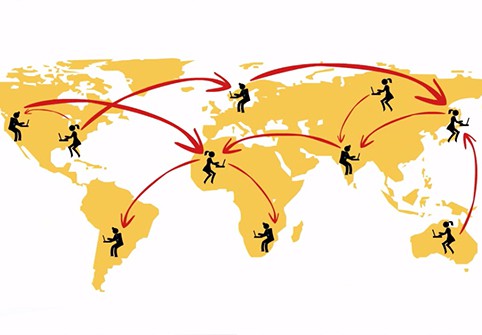4 Projects for Building Global Connections

Recently I connected with passionate teachers on a breezy Honolulu Saturday to learn and share our visions of global education at iTeach808, sponsored by Sacred Hearts Academy and the Augustine Educational Foundation. This excellent model of professional development combined the best elements of conference learning — a strong keynote by Stacie Berdan, author of Raising Global Children and a small number of carefully curated workshops — with a more intimate setting for learning collaboratively.
I was grateful to share at the free mini-conference some of my in-the-weeds experiences in a presentation on building global connections. I invited my fellow educators to explore ways to connect students with other learners around the globe: responding to a book, sharing stories, presenting an idea, and saving the world. We can begin a practice of global education first by leaning in, then making friends, sharing passions, and collaborating to take action about what matters.
Lean in
Adopting a global mindset is the first step, says Stacie Berdan. But even when we know in our hearts as teachers that connecting globally is essential for our students’ futures, we must tap our courage to reach beyond our classroom walls. Leaning in to join with global projects that already exist is an easy way to begin.
International Holocaust Remembrance Day
Literally add your class to the map of those who take time to honor those who have been killed in the holocaust. Share your activities with the community or the world by publicizing your event and creating a digital space for interaction.
International Dot Day (Sept. 15-ish, ongoing)
It’s not too late to take part in International Dot Day! You can join educators and students from around the world in celebration creativity and self-expression — inspired by Peter H. Reynolds’s picture book The Dot. Classes connect online, read Reynolds’s book, and design a project to share with one another. A handbook provides a good starting place for ideas. (Make connections on your own and share on the website gallery page.)
More information can be found at:
Make friends
Making friends means building relationships over time. If we make friends around the globe, we are establishing the lasting ties that can make a difference for our future. Reading and writing together allows us to make connections and learn to respect diversity.
Global Read Aloud (Oct. 5-Nov. 15, 2015)
Connect with readers worldwide by reading the same book aloud in real at time. Books are selected by participants in the spring, and teachers sign up to read books aloud with their classes or do an author study based on their grade level. Teachers can connect through a form or find partners via Facebook or Edmodo. Or they can join communities on WriteAbout or Sway. There’s also a “slow chat” on Twitter. Teachers and students decide on the format for sharing while they are reading.
Quadblogging (Flexible)
Students comment on each other’s writing in quads, connected classes from around the world. This is a great way to extend your students’ blogging to an authentic audience beyond the classroom. Writing prompts start you off each week with each classroom taking a turn as the “focus” for comments and interaction.
Share passions
Adults aren’t the only ones captivated by TED. Students watch and learn from TED Talks too. Imagine the result of empowering students to give TED-style talks at school or to watch and discuss talks in TED Ed Clubs. Take this to the next level by livestreaming a TEDx event or, even better, collaborating with “sister” schools across the globe to share passions and dreams with one another. Although this kind of project requires a significant commitment of time and resources, the results can be transformative for students.
TEDxYouth (November 20 and year-long)
For the past several years, TEDxYouthDay has promoted real-time TED programs for kids in conjunction with Universal Children’s Day in November. Schools can apply to host a TEDxYouth program any time of the year, but can generate connections by joining the Universal Children’s Day celebrations across the globe. Students can create powerful TED-style presentations to stream live and post for later viewing. Sharing through TED promotes connections beyond your event.
For more information, see:
- TEDxYouth Day 2014
- TEDxYouth Toolkit
- TEDxYouth on Twitter
- TEDxYouth on Facebook
- International Youth Day
Save the World
Students and teachers can find a deeper sense of purpose by finding ways to connect with like-minded learners to solve real-world problems. Using Pernille Ripp’s Global Read Aloud as a model, what can you think of to build global connections and make a difference?
I’ve tried drawing upon my experience using J.F. Rischard’s High Noon: 20 Global Problems, 20 Years to Solve Them as a starting place to employ a design thinking model with teams of students to study real-world problems. They connect with empathetically with individuals around the globe to solve them. “Genius Hour” time allows students to dive deep into a project. You can read about my initial experiences with Design Teams in a previous post at Getting Smart, “Creating Authentic Jobs for Student Learning Teams.”
Here are some additional resources:
- How to Use Design Thinking in Your Next Project
- Design Thinking at the Nueva School
- Design Thinking for Educators
Global Education Conference Network (free online conference: November 16-19, 2015)
Finally, it’s essential for teachers to reach out to make the kinds of connections that will provide the foundation for the work their students can do. My go-to source for making those kinds of connections has been the Global Education Conference Network. They’ve just held their first Global Collaboration Day. I’ve attended a number of their Global Education Summits, conveniently held the morning before the start of ISTE’s annual conference. (It has become so popular, I had to get on a waiting list to attend this year!) I’ve also taken part in their free online Global Education Conference offered each year in November. My connections to this group have kept my global commitment alive even when I’ve felt overwhelmed by the here and now of my teaching.
One of the key points I took away from the last Global Ed Summit I attended was the need to make global education a priority, top to bottom, in schools. Maybe the kind of event I attended this past weekend can be the start for moving schools into our globally connected world.
For more blogs by Susan, check out:







0 Comments
Leave a Comment
Your email address will not be published. All fields are required.